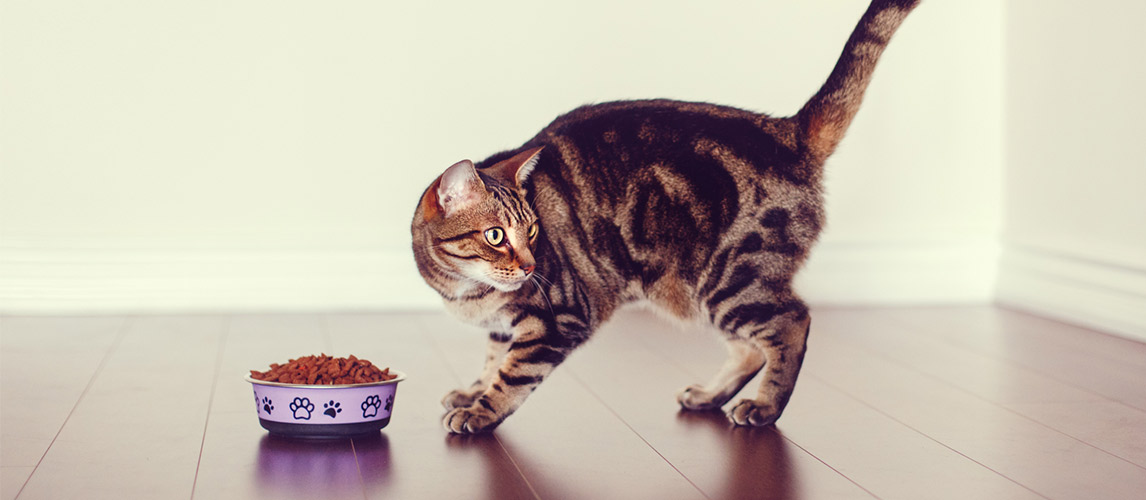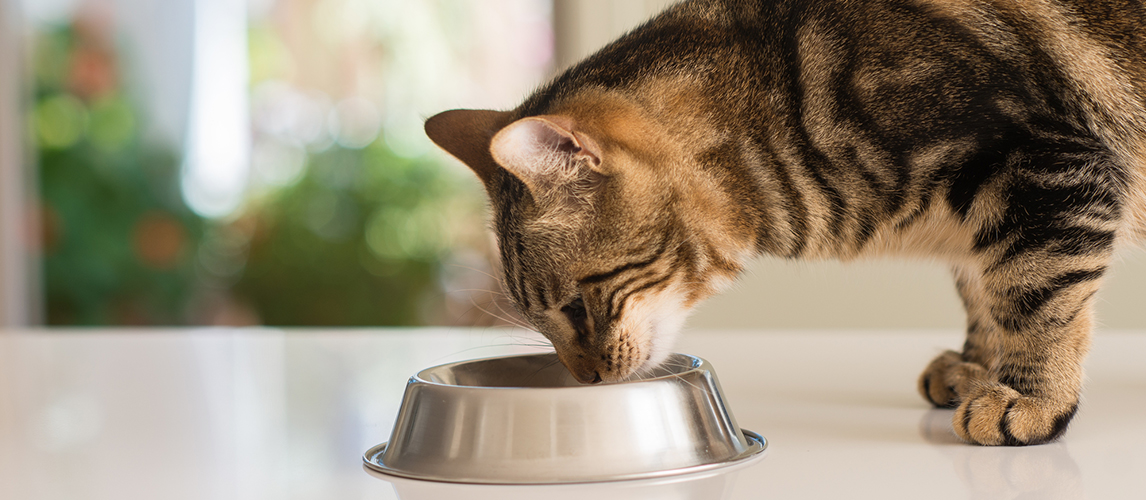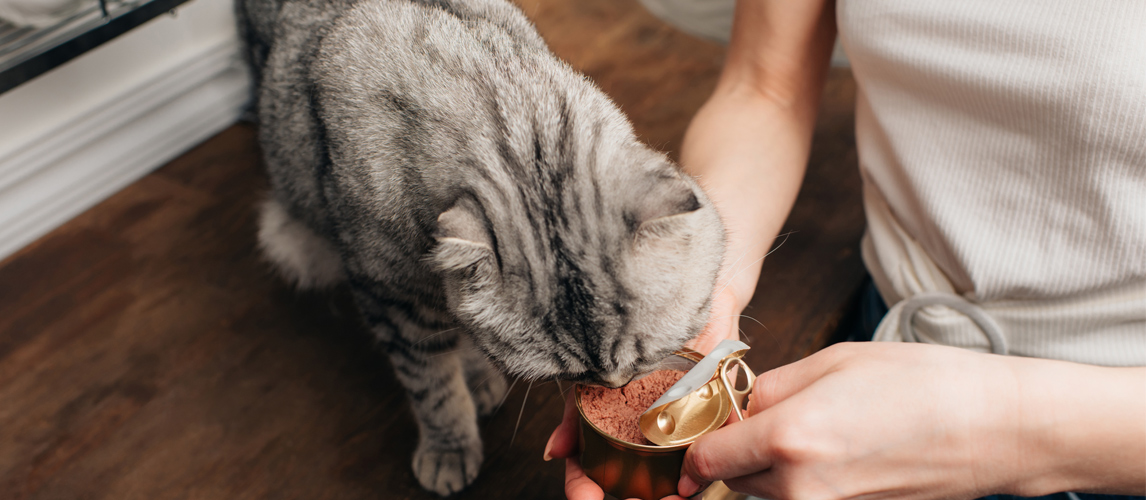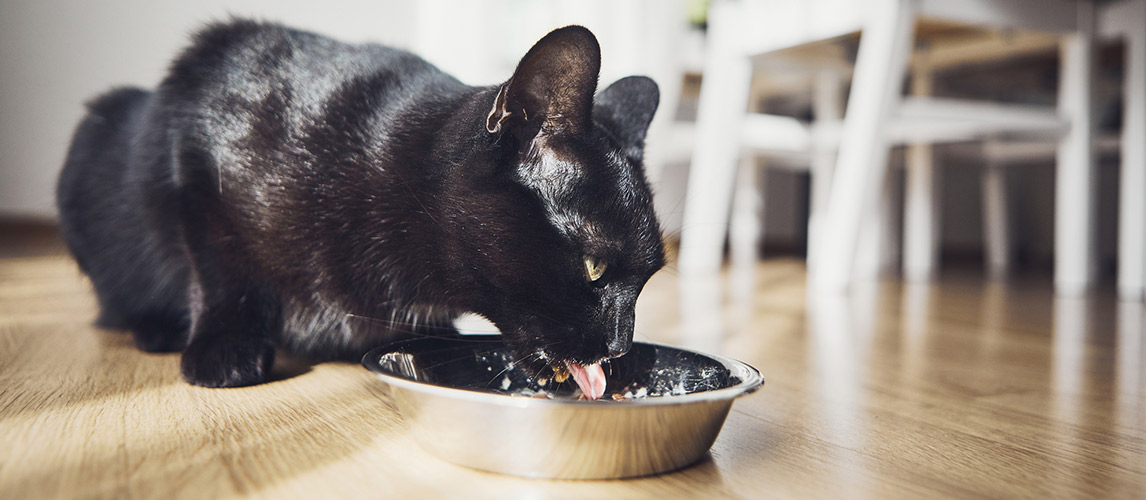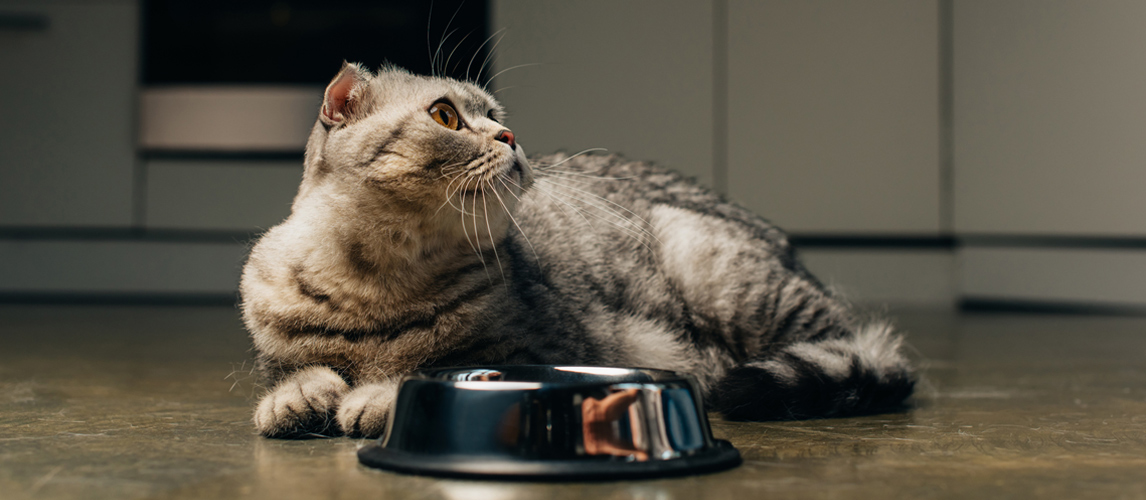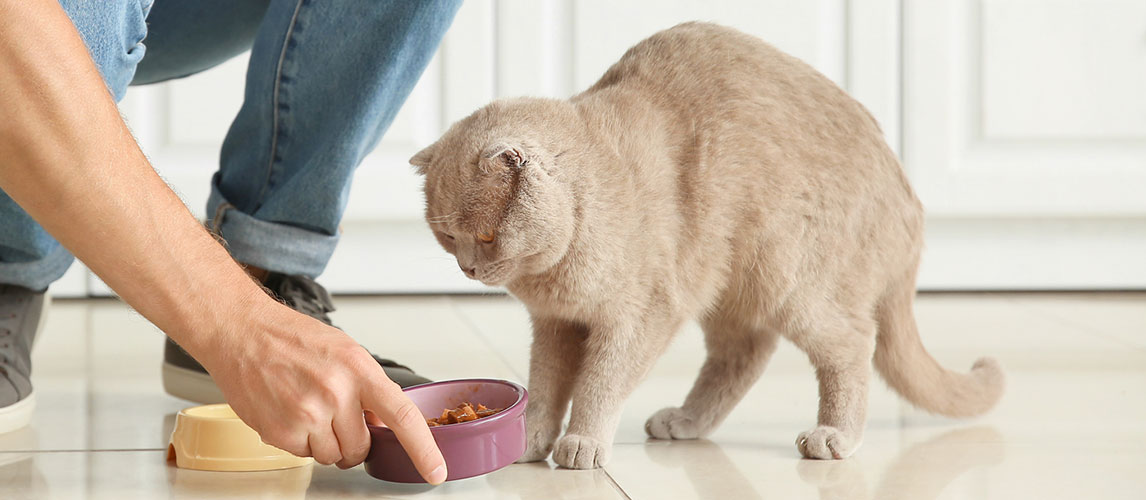
Kidney disease is a serious but sadly common condition in cats. It causes excessive urination and drinking, weakness and a loss of appetite and is diagnosed by a blood test. It is more common in older cats and it can be successfully managed in many cases by switching your kitty to a special therapeutic kidney diet.
Food for cats with kidney disease is specially formulated to ease the strain on the kidneys and promote renal function. It has low levels of protein, phosphorous and sodium and added omega 3 fatty acids. Switching your kitty over to a new diet can be tricky so here is a guide of the best cat foods for kidney disease so you can make the right choice.
The Best Cat Food for Kidney Disease
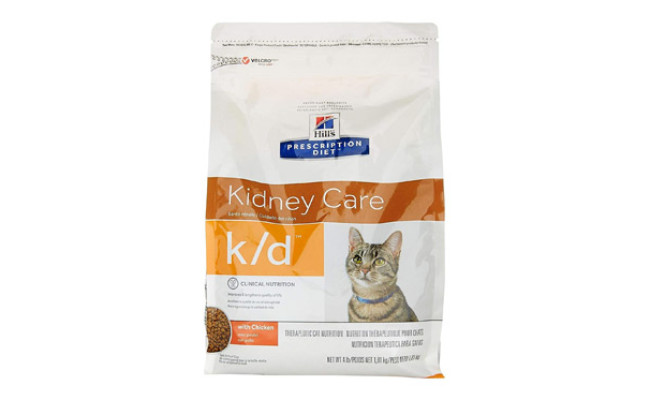
Delicious chicken-flavour therapeutic dry food to maintain kidney (renal) health. It has a maximum of 29 per cent crude protein to reduce the impact on the kidneys. It is a low phosphorus cat food with levels no more than 0.75 per cent to keep the stress on the renal system to a minimum. The food contains no more than 0.29 per cent sodium which helps to keep blood pressure low.
The high levels of omega 3 fatty acids in Hills kd cat food have been added to support the health of the kidneys and the B complex vitamins will help to replace those lost in the urine. With this carefully formulated diet, your kitty can look and feel better.
For more information on the brand, check out our review of Hill’s Cat Food.
Delicious chicken flavour
Dried food
Low protein, phosphorous and sodium for kidney health
High in omega 3 and B vitamins
- Brand: Hill’s Pet Nutrition
- Model: FBA_HLL-371
- Weight: 4 pounds
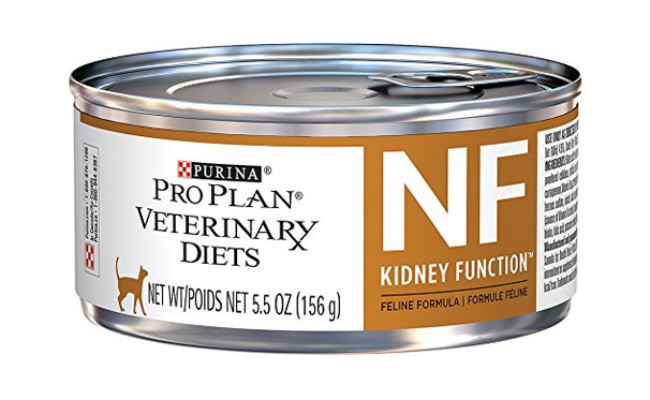
A moist, canned food with a paste-like consistency to which you can add further water if you wish. The ingredients are given as minimum seven per cent crude protein which is less than in regular cat foods. The phosphorous levels will not be over 0.18 per cent to maintain healthy kidney function and the sodium level is below 0.1 per cent.
Owners have found that their cats were happy to eat it although as with all foods some particularly picky eaters would not touch it. Many put on weight and looked better.
For a full list of our favorite options, see our round-up of Purina Cat Food.
Moist canned food
Seven per cent crude protein
Very low phosphorous levels – 0.18 per cent
Maintains kidney health
- Brand: Veterinary Diets
- Weight: 9 pounds
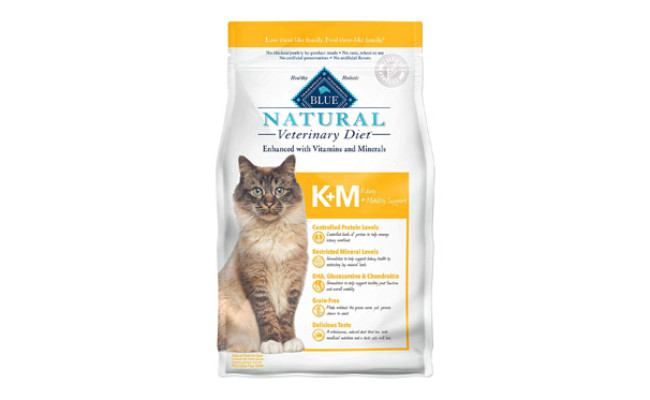
A wholesome, dry cat food in a veterinary diet formulation as a kidney diet for cats. The levels of protein, calcium, phosphorous and sodium are highly controlled. The added docosahexaenoic acid (DHA) which are omega 3 fatty acids will work with the glucosamine and chondroitin to maintain joint function and keep your kitty mobile.
It’s a totally natural product with no artificial preservatives, colours or flavours so you do not have to worry about adverse reactions. There is no corn, wheat or soy to trigger allergies.
You may also like our detailed review of Blue Buffalo Cat Food.
Natural product with no artificial additives
Highly controlled protein, calcium and phosphorous levels for kidney health
Low sodium content
No corn, wheat or soy to trigger allergies
- Brand: Blue Buffalo Natural Veterinary Diet
- Model: 801385
- Weight: 7 pounds
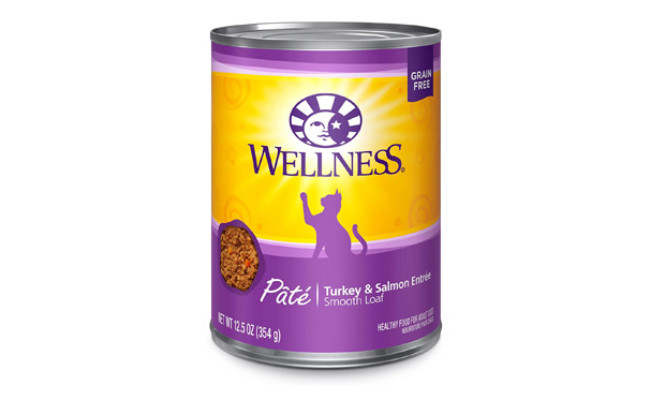
A tasty turkey and salmon loaf tinned cat food made from fresh meat and natural ingredients. Many other flavours are available to suit your kitty’s tastes. Packed with natural ingredients such as carrots which are high in antioxidants (to fight inflammation) and cranberries for a healthy urinary tract.
The product is grain free but contains flaxseed to promote a healthy coat. It complies with the Association of American Feed Control Officials cat food nutrient profile and has a minimum of 10.5 per cent crude protein. Plenty of moisture is included to help with kidney health and magnesium levels are low.
Read here our detailed Wellness Cat Food Reviews.
Wet food to increase moisture intake
Carefully balanced protein, fat and carbohydrates
Cranberries for urinary tract health
All natural ingredients
- Brand: Wellness Natural Pet Food
- Model: 8809
- Weight: 9.38 pounds
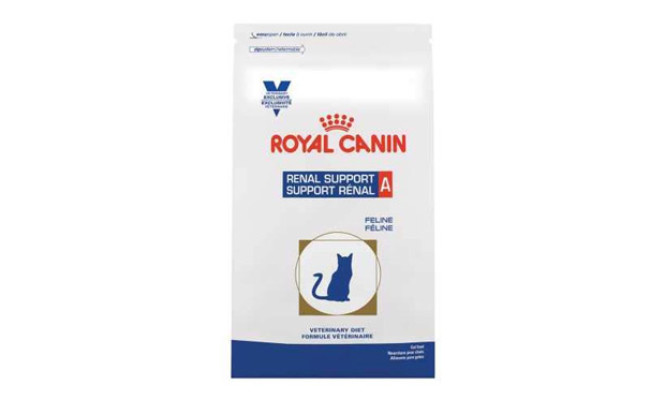
A special renal diet for cats formulation with low protein (maximum 25 per cent). It’s a low phosphorus cat food (maximum 0.57 per cent). There are added long chain omega 3 fatty acids (eicosapentaenoic acid and docosahexaenoic acid) which help to calm down inflammation of the urinary system. The combination of soluble and insoluble fibre is good for digestion.
It’s an ‘A’ formula which means that it’s aromatic which will help to attract cats who have lost their appetite due to kidney disease or old age. The small size of the kibble is perfect for older cats who may struggle to chew larger pieces.
Renal support formula with maximum 25 per cent protein
Maximum 0.57 per cent phosphorous to help kidneys
Added omega 3 acids
Aromatic and small kibble to entice cats with poor appetite
- Brand: Royal Canin
- Model: 583566
- Weight: 6.6 pounds
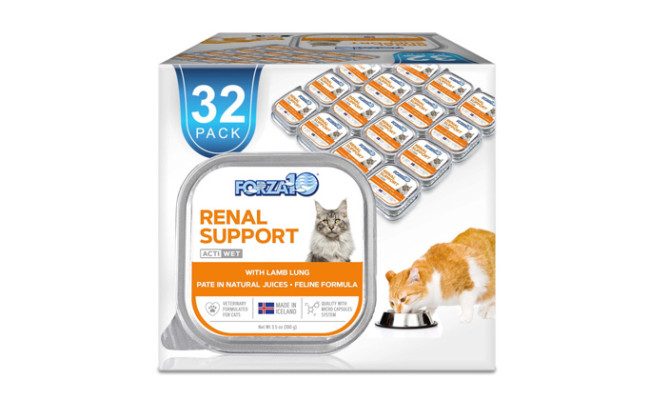
Not only does Forza10’s cat food commit to fast results for cats with chronic or acute renal failure, but it assists with congestive heart failure and other conditions that require low sodium, protein, or phosphorus diets. This Veterinarian formulated wet food contains dried dandelion root, to remove excess liquid and encourage diuretic action, as well as dried clover extract which purifies the urinary system, and cranberries that have significant disinfectant properties on the urinary tract.
Not to mention this formula also promotes a stronger immune system and healthy coat to keep your cat happy and healthy.
Free from harmful antibiotics (oxytetracycline), GMOs, soy, wheat, corn, and by-products
Fast results
Made with dried dandelion root extract, cranberries, dried clover extract
Pasture-raised New Zealand lamb flavor great for picky eaters
Suitable for all adult cat breeds
- Brand: Forza10
- Model: FPFZ1310000002
- Weight: 32 pack
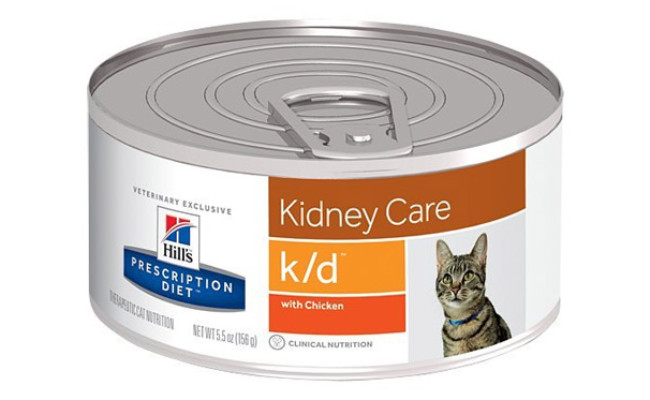
A chicken-based tinned renal diet for cats formulated by vets. This kidney diet for cats is made from minced chicken meat in jelly to encourage fussy eaters. Vets have come up with the formulation to help cats diagnosed with kidney disorders.
The protein is high quality (14 per cent is chicken) and at controlled levels – 28.9 per cent. There is added fish oil providing omega 3 fatty acids to reduce inflammation and improve blood flow in the kidneys. The antioxidants are added to cancel out free radicals which can also cause inflammation. Carefully controlled levels of both phosphorus (0.38 per cent) and sodium (0.30 per cent) to support kidney function.
Chicken base with tasty jelly
Low protein, phosphorous and sodium
Added antioxidants and omega 3 fatty acids
- Brand: Hill’s Pet Nutrition
- Weight: 9 pounds
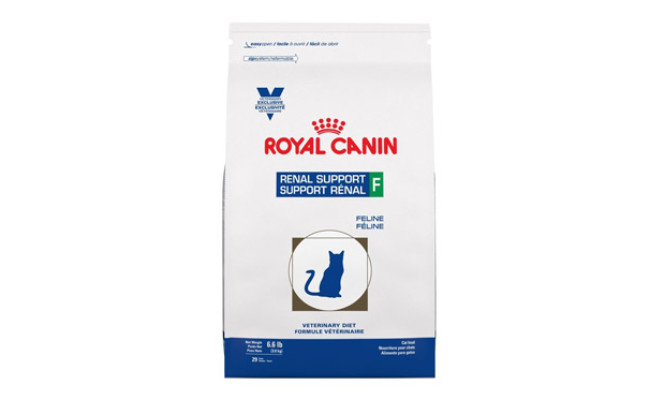
This Royal Canin dry cat food is formulated and recommended for adult cats with chronic kidney disease. In particular, it can help with a condition called calcium oxalate urolith recurrence which causes impaired kidney function.
The odour and texture of the kibble are designed to attract kitties who do not have a good appetite so that they can put weight back on. There is a maximum of 28 per cent protein and a maximum of 0.6 per cent phosphorous to avoid overloading the kidneys. The added omega 3 fatty acids help general health.
Kibble with attractive odour and texture
Reduced protein (28 per cent) to protect kidneys
Reduced phosphorous (0.6 per cent) to protect kidneys
Added omega 3 fatty acids
- Brand: Royal Canin
- Model: 583066
- Weight: 6.61 pounds
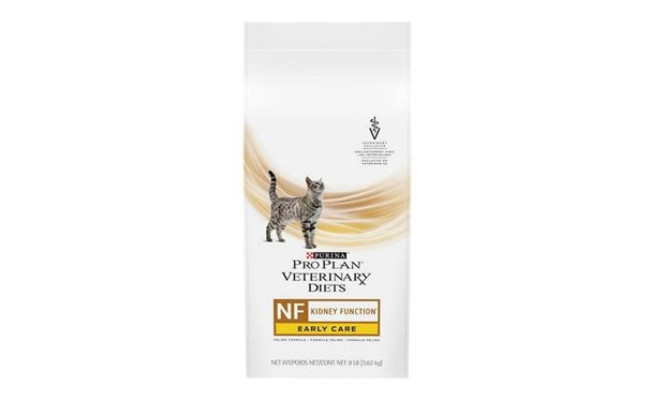
A diet specifically formulated for the early care of cats with diagnosed kidney disease. It has low phosphorus levels to limit renal damage and the low protein levels cut down on non-essential amino acids and so cut down on waste that the kidneys must remove.
Damaged kidneys are not so good at regulating the levels of sodium in the body so the sodium concentration in the food is controlled. There are added omega 3 fatty acids to help reduce the blood pressure in the kidney structure.
Read in-depth our review of Purina Pro Plan Cat Food.
Low non-essential amino acids
Low sodium and phosphorous levels
Added omega 3 acids to control pressure in kidneys
- Brand: Purina Pro Plan
- Model: 17901
- Weight: 8.2 pounds
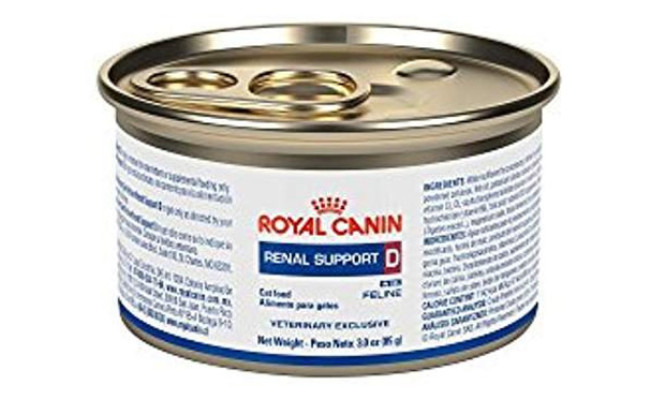
The combination of meaty morsels and thick gravy has a texture and odour to attract reluctant feeders to increase their calorie intake and overall health. This moist food provides a lot of energy per mouthful and is easy for cats to digest.
The low protein levels (maximum 9.5 per cent) and low phosphorus levels (maximum 0.15 per cent) make this a food that should only be used when recommended by a vet.
Use only when recommended by a vet
Very low protein and phosphorous levels
Aromatic and palatable to encourage feeding
High energy
- Brand: Royal Canin
- Weight: 4 pounds
Best Cat Food for Kidney Disease Buying Guide & FAQ
How Protein Restriction Impacts Healthy Body Condition
Cats need protein to stay healthy. Protein is an essential element of the feline diet and without it, your kitty cannot survive. Cats are also natural carnivores and get their protein intake from meat. They can use protein as an energy source but it is also used for the growth and repair of tissue.
In order to use protein, the body breaks it down into amino acids and this produces waste products. The kidney is the organ that filters these waste products out of the bloodstream and gets rid of them by excreting them in urine. Therefore, the more protein your cat eats, the more waste products are produced and the harder the kidneys have to work. In theory, by eating less protein, the kidneys can be protected.
However, the quality of the protein eaten is also important. It is always a good idea to check out the ingredients list and see what quantity of high-quality protein (such as chicken) is included. Swapping low-quality protein for high-quality protein cuts down on digestive waste and is good for overall health.
Bear in mind that protein is an important element of your cat’s diet and a low protein cat food should only be introduced under the supervision of a vet.
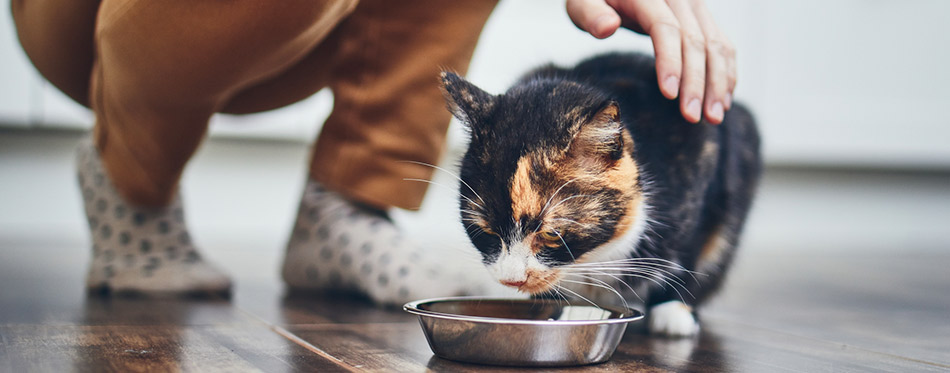
Therapeutic Kidney Diets
Kidney disease can affect cats of all ages and it can be an acute (sudden and serious) condition or a chronic (longer lasting) one. Acute kidney disease in younger cats can be caused by poisons, shock, infection or heart problems. Provided it is caught early and treated by a vet, your cat will often make a complete recovery.
Chronic kidney disease, however, is completely different. It is usually found in older cats (over seven years old) and develops gradually over a period of months or even years. You may start to notice your older kitty may be urinating and drinking more often, seems weak and is losing weight. It’s not always clear what has caused the problem and there is no simple treatment. The cat usually has to learn to live with the condition with a combination of medication and a special diet to try to make them feel better and to prevent the kidney disease from getting worse.
Some foods are specifically formulated to support a cat with kidney disease. A therapeutic kidney diet will usually have:
- Low protein or at least low levels of poor quality protein and more high-quality protein. Some foods give the maximum percentage of protein on the label.
- Low phosphorous which is an element that is controlled by the kidneys.
- Low sodium which is another element controlled by the kidneys
- Added omega 3 fatty acids
- Added vitamins
- Added moisture
- A carefully controlled aromatic profile that smells good to cats
Benefits of Therapeutic Kidney Diets
The various carefully controlled elements of a therapeutic diet work together to support the health of a cat with kidney disease. The best cat food for kidney disease will have the following.
- A low concentration of high-quality protein
When the gut breaks down protein into the building blocks that are used for tissue growth and repair (amino acids) toxic substances are produced and the kidney is supposed to remove them from the blood. When the kidneys are not functioning as they should, these toxins are left in the blood and make your kitty feel poorly. Reducing protein in the diet reduces toxins and makes them feel better. It is important to make sure that the small quantity of protein that they do eat is of a high quality and is doing them a lot of good.
- Restricted phosphate concentration
When the blood levels of phosphorus are high, the rate of kidney damage is speeded up. When blood levels of phosphorous are low, it is slowed down. It is therefore preferable for a cat with kidney disease to have a low phosphorus cat food. Balancing the blood concentration of phosphorous also makes your kitty feel better.
Restricting your cat’s intake of phosphorous will reduce the likelihood of them developing Renal Secondary Hyperparathyroidism which is a serious condition. It also reduces calcification of the kidneys. In addition to recommending a low phosphorus cat food, your vet may prescribe some medication which will bind phosphorus in the intestines so it doesn’t have a chance to enter the bloodstream.
- Restricted sodium concentration
The blood levels of sodium need to be carefully controlled and it is the kidneys that perform this important function. When they are not working, the levels of sodium can build up. This can lead to an increase in blood pressure and a build-up of body fluid which puts even more pressure on the kidneys so it ends up as a vicious circle.
- Added omega 3 fatty acids
Essential fatty acids are sometimes called omega 3 fatty acids and the two most common ones are eicosapentaenoic acid (EPA) and docosahexaenoic acid (DHA) which are found in fish oils. They reduce inflammation in the kidney and help to stop the renal disease from getting worse.
- High moisture content
Some, but not all, therapeutic kidney diets have a high moisture content. Damaged kidneys struggle to control the water balance in the body and dehydration is a real possibility. It can be hard to get cats to drink and so getting some fluid inside them via their food is a good idea.
- Aromatic profile
‘Aromatic profile’ is a scientific way of saying it smells good or at least your kitty will think so! Cats with kidney disease often lose their appetite and lose weight. A smelly and tasty renal cat food will encourage them to eat.
Take a look at our guide on the Best Wet Cat Food.
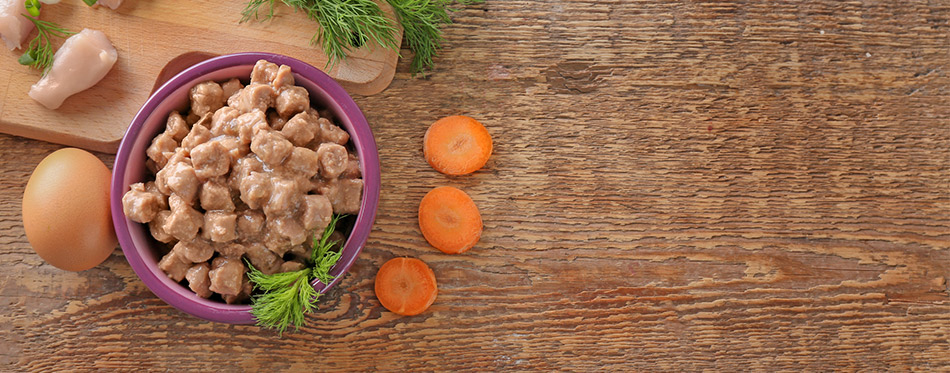
The Importance of Water for Cats With Kidney Disease
Cats with kidney disease can quickly become seriously dehydrated and this is potentially life-threatening, so it is something that you should be looking out for. It is not unusual for a healthy kitty to fail to drink enough water to keep themselves well and this situation is magnified in a poorly cat.
The kidneys regulate the water concentration in your cat’s body so when they are not working properly, they cannot conserve water by making the urine more concentrated. They just carry on losing water in the urine and if they don’t take on enough water to make that up, they will be dehydrated. You will need to find ways of getting enough water into your cat.
Check out our review of the Best Water Bowl for Cats.
- Cats prefer cool and fresh water. Make sure that you change their water bowl often and pop in a few ice cubes on a warm day.
- Place several water bowls in different locations around your home and in quiet places where your kitty will not be disturbed when they are having a drink.
- Don’t expect your kitty to share a water bowl with another cat because they hate doing that! It must be one bowl per cat in the house.
- Think about getting a water fountain. These supply a constant trickle of cool clean water that is very attractive to cats. In nature, they would choose to drink from a stream.
- If you are not able to get a fountain, you could leave a faucet (tap) dripping as well as a water bowl.
- Switch away from dried food. Canned food that is made from a paste or meaty morsels in jelly or gravy will naturally have more water in it.
- Some cats need additional fluids given intravenously using a needle. Your vet can do this but they may also teach you how to do it at home. You will be provided with a special fluid to inject by your vet.
Find out more about Hypoallergenic Cat Food.
Best Cat Food for Kidney Disease FAQ:
Q: When to start a therapeutic kidney diet?
A: There has been a lot of research into the benefits of starting a therapeutic kidney diet as soon as your cat is diagnosed with kidney disease. The results clearly show that the sooner you start the diet the better.
Once blood test results have shown that the kidney values (especially creatinine) are abnormal, your vet will probably recommend that you start the diet. Once the disease is advanced, your kitty may start to vomit and go off food completely and it can be very hard to convince them to try a new diet at this stage.
The important message here is that it is important to be on the lookout for the symptoms of kidney disease (excessive drinking, urination, weight loss and weakness) especially in older cats. A prompt diagnosis followed by a prompt switch to a renal cat food gives your kitty the best chance of enjoying several more years of relatively good health.
Q: How to introduce a therapeutic kidney diet?
A: Cats are not always big fans of switching diets at any stage of their life but when they are ill and possibly also elderly, it can be a big challenge.
A gradual change is likely to be more successful. Be prepared for the switch to take a few days and it may even take a week or so. At the start, take a teaspoon of the low protein cat food and mix it in very well with your cat’s usual food. Very gradually, increase the amount of new food that you add until the meal entirely consists of the new food.
Manufacturers are increasingly recognising that low protein cat food is not palatable to many cats. They are working hard on ‘aromatic profiles’ which means that they are trying to make the food smell delicious. You could try a few types of food to see which your kitty prefers. Many owners have had more success with pate (loaf) type food or morsels in gravy or jelly. Other owners have found that small kibble with an attractive smell is more appealing to older cats. You may find that warming the food so that it is at body temperature (around 30 degrees C) when you serve it will help.
In most cases, the transition to food for cats with kidney disease will eventually be successful but always keep some of the old food in your house in case of setbacks. Your kitty has to eat something!
If things are going very badly, you should talk to your vet because they may be able to prescribe some medication to increase the appetite and aid the transition.
Q: How often should I retest blood values?
A: The initial blood test carried out by your vet will determine the levels of urea and creatinine. High levels indicate that the kidneys are not functioning properly.
A new blood test for a substance called SDMA is now available which can detect the very early stages of kidney disease when there is less damage. Creatinine levels may not increase until 70 per cent of the kidney tissue is affected. The blood tests may also reveal that the blood urea nitrogen (BUN) levels are raised, the red blood cell count is low and the phosphorous levels are high.
The creatinine levels will dictate the recommended treatment. If the levels are below 2.8, your vet will probably recommend a switch to a therapeutic kidney diet and re-testing in six months.
You may also like our review of the Best Cat Food for Bengals.
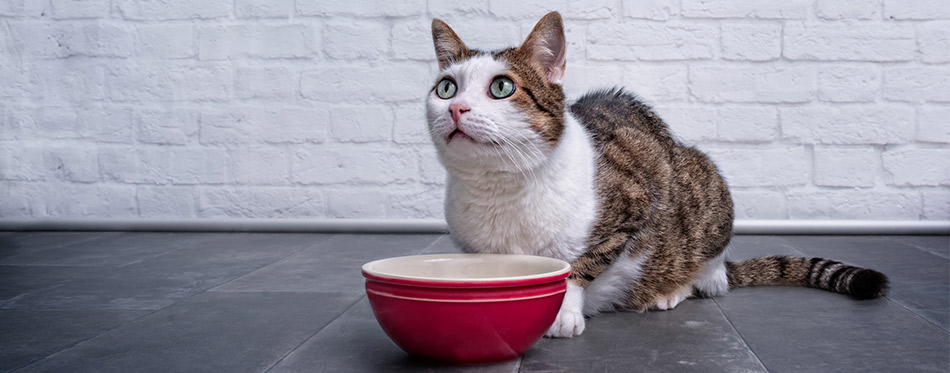
Our Top Pick
An enticing chicken dry food with a maximum of 29 per cent crude protein and a maximum of 0.75 per cent phosphorous to reduce stress on the kidneys. Low sodium levels to keep blood pressure low.
There are omega 3 fatty acids and B complex vitamins added to help your cat feel better.
Sources:
- Shawn Kearns, DVM, DACVIM, Chronic Kidney Disease Management in Cats, The MSPCA–Angell
- Kidney Disease in Cats: Causes, Signs and Treatment, Best Friends Animal Society
Sharon is a Ph.D. scientist and experienced pet content writer. As a life-long animal lover, she now shares her family home with three rabbits, a Syrian hamster, and a Cockapoo puppy. She has a passion for researching accurate and credible information about pets and turning it into easy-to-understand articles that offer practical tips. When it comes to our furry friends, she knows that there is always something new to learn!
